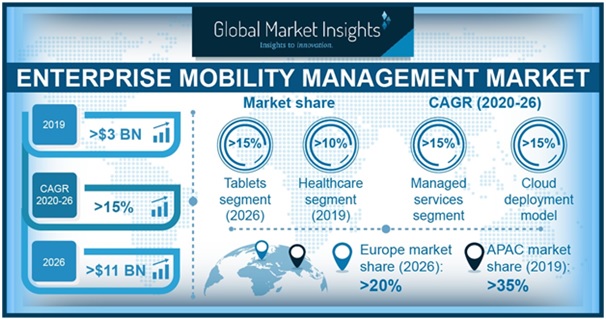“We are no longer in a mobile-first world, we are in a mobile-only world.” – Larry Page
The whole world is encapsulated by two things – one good and one bad. The good part is the enterprise mobility wave that has captured almost all industries under its umbrella and the bad part is the Covid-19 pandemic that has disrupted the way the globe operates. It has impacted all industries of all sizes and segments, across all geographies.
But one thing that has changed drastically is the way enterprise mobility is being sought after, at an increasing spree, after the pandemic has begun. Of course, bunched with it comes a lot of challenges but they are worth it as they have their own key solutions.
Till now, there were a few enterprises who were yet to leverage mobility, citing many reasons that were hard to believe. But this pandemic has almost forced all to change their way of thinking and adapt to the latest technological moves, enterprise mobility being one of them.
The ‘work from home’, ‘social distancing’, ‘lockdowns’, ‘shelter in place’ terminologies were reasons big enough to encourage enterprises to adapt to the Bring Your Own Device (BYOD) culture.
Enterprises who were techno savvy could easily embrace the new way of working, others took time to implement the needed norms. This sudden revolution changed the focus more towards implementing enterprise mobility. A need for a comprehensive and robust enterprise mobility procedure is a must now.
Organizations worldwide are depending upon enterprise mobility to leverage the optimum technological investments, as compared to what they did earlier.

BYOD Is in Demand Again
Till now, the employee task force was used to bringing their own devices at their work areas and now, with the new situation, they are using their own devices for their work from their home premises.
Today, enterprises are dependent upon the BYOD concept since most of the organization’s work is happening through the employee’s own device. The BYOD era has regained momentum. All those organizations who were not much in favour of this, are forced to enter the tech age.
Enterprise Mobility – Key Challenges and Solutions in the Covid-19 Crisis
As the need for enterprise mobility increases during this heavy period, so do the associated challenges. Thanks to the digital transformation era and the power of technology, these hurdles are being met and businesses are leveraging the power of the BYOD concept.
Here are some of the major hurdles that could cause enterprise mobility functioning to be difficult and its possible solutions:
- Matching Up to Budgeted Costs
During these difficult times, sticking to the investment costs and budgets is quite a tough task. There are changes, in the way of working, infrastructure, administration, management and all. Hence, matching up to existing budgets is a hurdle.
At such times, enterprises should move towards reasonable software solutions that comprise of an all-inclusive range of functionalities that can offer a real-time view of the organization.
Cost effectiveness in business functioning is a must. It is being tested in this crisis but if managed and planned properly, it can be done well. Enterprise mobility functionalities must be guarded well, managed, and monitored intricately to operate within stipulated budget frames. The tomorrow is surely bright then!
- Devices to Breakdown and Cause Downtime Issues
The more the merrier, but riskier too! As the entire taskforce shifts towards the BYOD regime, it is a great start for the business, provided all mobile devices function at their best, all the while. What if the mobile devices start misbehaving or conk of? That is big challenge, since it leads directly to a longer downtime for the team members.
But there is always a solution to minimize the aftereffects of this challenge. Mobile devices need to be monitored and managed more closely once they are being used professionally by all. Possible problems must be identified well ahead of time, so that they may not create any issues later.
The pre-emptive way of working is highly recommended for effective management of remote working devices. It helps in seamless business functioning, inter department communication and a great uptime. Maximum leverage of costs included can be attained if the mobile devices are monitored and maintained well.
- Having the Right Enterprise Mobile Apps
Mobile apps are a must for enterprises to operate efficiently from their own remote work areas. Most of the task force makes use of mobile apps to perform their assigned functionalities. What is more important is the apt usage of enterprise mobile apps, rather than choosing those that do not offer proper user experience. Performance of good enterprise apps can lead to a great productivity level while those not worth it, can lead to a loss of productivity.
- Investment in the Apt Infrastructure
For those who already have an enterprise mobility setup, there is not much to do, except gel well with the current requirements and make necessary changes. The major crux lies with those enterprises who have had to adapt mobility because of the crisis. They have a lot to do, mainly investing in the right kind of infrastructure.
Be it mobile devices, OS, frameworks, they must look at it all and that too, within a stipulated time frame and budget. That is tough to do, provided there is lot of effort put in planning addition of devices, their infrastructure, placement, and the entire implementation plan.
- Ensuring A Scalable and Versatile Environment
It is vital to have an environment that is scalable, able to handle multiple devices at a time. Addition of devices, as per need, should not be an issue to performance and security. That is a big challenge and a must when it comes to enterprise mobility.
The performance of the applications, versatility of devices, security of applications and mobile devices, responsiveness of app, memory utilization and component sharing must be monitored and ensured to its best.
Certain features in mobile apps like video streaming take up a lot of memory space. It comes up as a tough task to handle how much memory space should be allocated, how much is being utilized and how much is left.
- Maintaining Speed of Connections and Multiple Bandwidth
When there are so many networks working together, the speed factor plays an important role. The clients need a speedy performance and with multiple bandwidths, it could create an issue. Having a less speed performance may not make the customers happy and they may quit the application quickly. The overall customer experience may go low. That is why maintaining the speed of mobile apps, with relation to the devices, is mandatory and tough, both.
- Associating with an Enterprise Mobility Partner
When it comes to managing and maintaining multiple mobile devices, there is a need for throughout enterprise mobility management. At such times, taking support from an experienced enterprise mobility partner does help. Aligning with a partner helps in simplifying mobility functions along with proper security of the mobile devices.
As Enterprise Mobility Rules the World and Fights the Pandemic Crisis
For enterprises to perform at their best, enterprise mobility solutions are a must and organizations have realized that now. Almost all enterprises have embraced the goodness of mobility services and the pandemic has sort of, enforced that even more.
As we sail through the Covid-19 crisis, rest assured, enterprise mobility will take businesses to a greater height! Successful businesses shall rise, and the pandemic shall go down…



